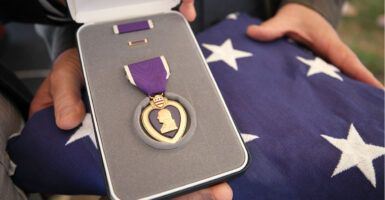The first time I was wounded, I bled little and required no serious treatment, but the soldier next to me, who bore the full brunt of the rocket-propelled grenade that struck our tank, was killed instantly.
He volunteered—begged, in fact—to be on the mission that became his last because he loved his job, loved his fellow soldiers, and loved his country.
His last act was preparing to fire his machine gun at an enemy position to protect our convoy. It was a final, fatal act of love. For that, he was posthumously awarded a Purple Heart.
I’m reminded of this by the approach of Purple Heart Day on Aug. 7.
When I was wounded in Iraq for the second time, I was transported by a Marine Corps helicopter to the nearest field hospital. When I arrived at the hospital, nearly all of my own blood was gone, and I was in desperate need of more.
So much was required that I exhausted the hospital’s supply of stored blood of my type. So, they went to the mess hall and solicited volunteers to donate.
Twenty-five sailors and Marines who I did not know and would never meet got up from their dinner and came and donated their blood into bags that were then transfused into my body, saving my life.
Those profound acts of selfless love illustrate the meaning of the Purple Heart to me. Of the many decorations that the United States military awards, few are more famous or storied than the Purple Heart.
Its fame is interesting, both because it is far from the highest award given—for the Army, at least 10 outrank it—and because it’s a decoration that is earned not by your doing something, but by having something done to you. (That has led to dark jokes among those who have served about the Purple Heart being an “enemy marksmanship badge” and the like.)
The roots of the Purple Heart trace back to 1782 and George Washington himself. Washington devised an award called the Badge of Military Merit, which was to be given in recognition of “any singularly meritorious action” and which was to be a “figure of a heart in purple cloth or silk edged with narrow lace or binding” and affixed to the uniform coat above the left breast.
Though it fell into disuse after the Revolution, it was revived in 1932 as an award to recognize those who had received wounds from combat with an enemy.
It is unclear why Washington selected the heart shape for his award, but it is altogether appropriate for the award, for two reasons.
First, the heart’s biological function of circulating blood draws attention to, and fits well with, the Purple Heart’s purpose of recognizing the spilling of blood in service to one’s country. Second, the heart shape draws attention to what ultimately underpins the willingness to sacrifice for one’s country; namely, love.
Since ancient times, the heart has been associated with love. Despite the superficial romantic connotations that are often applied to it in English, the concept of love goes far deeper.
St. Augustine argued that love is the force that binds all human societies together and that shared love is what makes political communities possible.
And at its core, love entails self-sacrifice. As Jesus Christ told his disciples, “Greater love hath no man than this, that a man lay down his life for his friends.”
In this sense, the Purple Heart is about love—love of country, of comrades, of fellow citizens, of all humanity. It represents the highest form of self-giving.
As Gen. Douglas MacArthur said in his “Duty, Honor, Country” speech: “The soldier, above all other men, is required to practice the greatest act of religious training—sacrifice.”
I am immensely proud of my service and sacrifice, and am proud to be wearing the oldest decoration in the U.S. military.




























